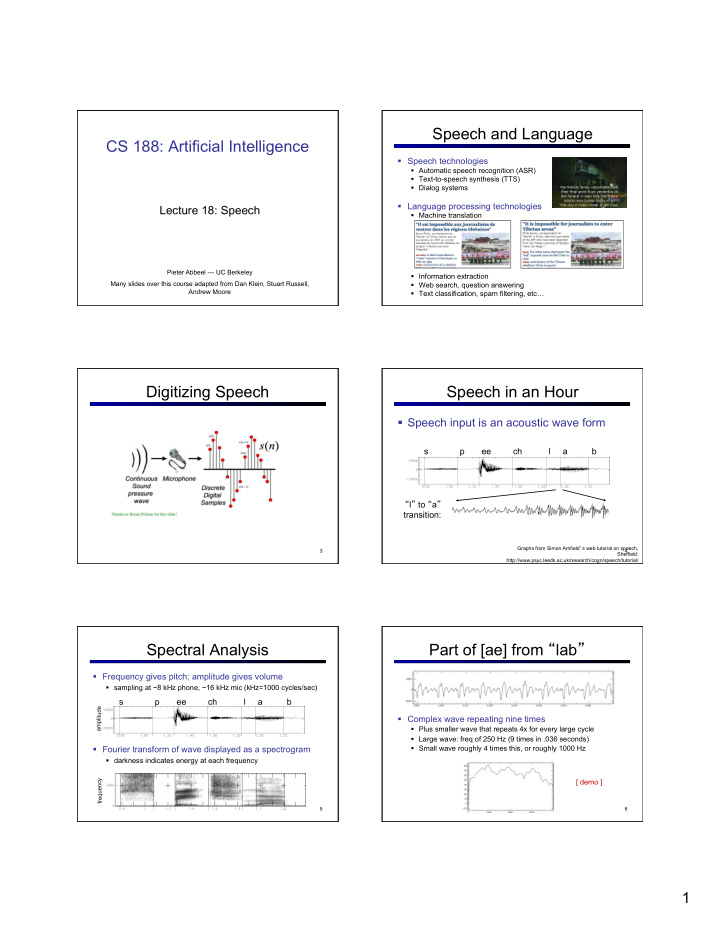



Speech and Language CS 188: Artificial Intelligence § Speech technologies § Automatic speech recognition (ASR) § Text-to-speech synthesis (TTS) § Dialog systems § Language processing technologies Lecture 18: Speech § Machine translation Pieter Abbeel --- UC Berkeley § Information extraction Many slides over this course adapted from Dan Klein, Stuart Russell, § Web search, question answering Andrew Moore § Text classification, spam filtering, etc … Digitizing Speech Speech in an Hour § Speech input is an acoustic wave form s p ee ch l a b “ l ” to “ a ” transition: Graphs from Simon Arnfield ’ s web tutorial on speech, 3 4 Sheffield: http://www.psyc.leeds.ac.uk/research/cogn/speech/tutorial/ Spectral Analysis Part of [ae] from “ lab ” § Frequency gives pitch; amplitude gives volume § sampling at ~8 kHz phone, ~16 kHz mic (kHz=1000 cycles/sec) s p ee ch l a b amplitude § Complex wave repeating nine times § Plus smaller wave that repeats 4x for every large cycle § Large wave: freq of 250 Hz (9 times in .036 seconds) § Fourier transform of wave displayed as a spectrogram § Small wave roughly 4 times this, or roughly 1000 Hz § darkness indicates energy at each frequency frequency [ demo ] 5 6 1
Resonances of the vocal tract [ demo ] § The human vocal tract as an open tube Closed end Open end Length 17.5 cm. § Air in a tube of a given length will tend to vibrate at resonance frequency of tube. § Constraint: Pressure differential should be maximal at (closed) glottal From end and minimal at (open) lip end. Mark Liberman ’ s 7 8 website Figure from W. Barry Speech Science slides Vowel [i] sung at successively higher pitches Acoustic Feature Sequence F#2 A2 C3 § Time slices are translated into acoustic feature vectors (~39 real numbers per slice) frequency F#3 A3 C4 (middle C) …………………………………………… .. e 12 e 13 e 14 e 15 e 16 ……… .. A4 § These are the observations, now we need the hidden states X 10 Figures from Ratree Wayland State Space HMMs for Speech § P(E|X) encodes which acoustic vectors are appropriate for each phoneme (each kind of sound) § P(X|X ’ ) encodes how sounds can be strung together § We will have one state for each sound in each word § From some state x, can only: § Stay in the same state (e.g. speaking slowly) § Move to the next position in the word § At the end of the word, move to the start of the next word § We build a little state graph for each word and chain them together to form our state space X 11 12 2
Transitions with Bigrams Decoding 198015222 the first § While there are some practical issues, finding the words Training Counts 194623024 the same given the acoustics is an HMM inference problem 168504105 the following 158562063 the world … § We want to know which state sequence x 1:T is most likely 14112454 the door ----------------- given the evidence e 1:T : 23135851162 the * § From the sequence x, we can simply read off the words 14 Figure from Huang et al page 618 3
Recommend
More recommend